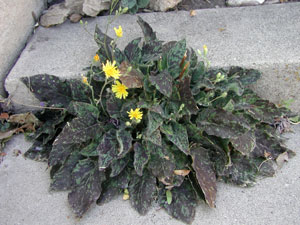Resource Library
Plant of the Week: Spotted Hawkweed
The University of Arkansas System Division of Agriculture does not promote, support or recommend plants featured in "Plant of the Week." Please consult your local Extension office for plants suitable for your region.
Plant of the Week
Spotted Hawkweed
Latin: Hieracium maculatum 'Leopard'

I’m reluctant to grow anything that has “weed” as part of its name, but sometimes it happens anyway. Such is the case with spotted hawkweed (Hieracium maculatum ‘Leopard’), a plant I first encountered in a rock garden in Utah. Since then, I’ve had some experience growing this species in Arkansas so I thought I’d throw my two cents into the voluminous discussion on the web about the hawkweeds.
Hawkweeds are members of the chicory tribe of the large daisy family and have flowers,
including windborne seed, superficially similar to dandelion. They are distributed
across the northern hemisphere on all continents with the number of species ranging
from a low count of about 800 to a high of more than 9,000. Hawkweeds, like dandelions,
have a unique form of reproduction called apomixes where the seeds are produced without
fertilization, so new plants produced are identical clones of the original seed parent.
This gives taxonomists fits so no wonder they can’t get together and decide how many
species of Hieracium exist in the world.
Spotted hawkweed is a native to central and western Europe.
Like most hawkweeds, spotted hawkweed has an affinity for cooler locations. It is a perennial that grows as a dense rosette with basal leaves that are wooly pubescent, 3 to 5 inches long and ovate in outline with gray-green coloration marked with camouflage marked blotches of reddish-brown. The literature says it produces stolons and can spread sideways from the clump but, at least with the plants I have grown, seems to only creep along in this fashion, forming a tight but slowly expanding clump.
The flowering panicle appears in mid spring and grows from 8 to 30 inches tall. It
is irregularly branched with 20 to 30 yellow blooms produced per panicle. The blossoms
are to an inch across and composed of flat-topped ray florets that are followed in
a few days by an inch-wide puffball similar to dandelion.
Hawkweeds are named such because of the ancient Greek name for the plants and the
modern Latin name – probably based on the way the seeds soar off on their little parachutes
– was taken from the Greek name for a falcon. This diverse genus is distributed everywhere
in the northern hemisphere and, like all widely distributed genera, has some strong,
vigorous growers that tend to be weedy and some that are timid and difficult to grow.
However, they all are collectively known as hawkweeds, and therefore damned by association.
For me spotted hawkweed – at least under Arkansas conditions – has not been an aggressive grower and I’ve seen no sign that it has spread by seed. In cool, moist areas of the Pacific Northwest, one gardener reports spotted hawkweed reseeds here or there in her garden but even under ideal conditions she didn’t consider it aggressive.
Because of this species affinity for cooler climates, I doubt it will escape cultivation
in the South. It isn’t a real show stopper of a plant so will never gain wide usage
in the garden. But if you are interested in growing it for its attractive foliage
but are concerned about possible escape, breaking off the flowering panicle as they
appear will eliminate seed production.
Spotted hawkweed is a smallish plant that could be used to border a shaded walkway
or used amongst rocks in the rock garden. It is not picky about soil type but does
prefer a more moist location. It will grow in full sun or part shade.
By: Gerald Klingaman, retired
Retired Extension Horticulturist - Ornamentals
Extension News - June 28, 2013
The University of Arkansas System Division of Agriculture does not maintain lists of retail outlets where these plants can be purchased. Please check your local nursery or other retail outlets to ask about the availability of these plants for your growing area.